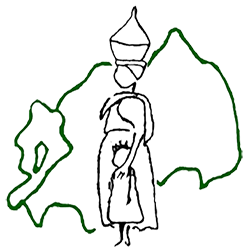Rwanda Village Community Promoters (RVCP) is a voluntary, youth-led NGO, formerly known as Rwanda Village Concept Project (R-VCP). R-VCP was a local project running in Rwanda within the framework of the Intersectoral Meeting of International Students’ Organizations (IMISO) of Village Concept Projects (VCP).
The original Village Concept Project (VCP) was pioneered by the International Federation of Medical Students’ Association (IFMSA). It is a series of development projects for rural villages in different parts of the world, which also serve as models for similar international students’ activities. In the 1980s, IFMSA wanted to promote the World Health Organization’s (WHO) concept of “health for all” by the year 2000 through primary health care. The project idea, aimed at improving the socio-economic conditions of villagers, came from a joint WHO-IFMSA leadership programme held in Geneva in 1986. It was designed to stem from the needs of the villagers and actively involve them in the planning, implementation and evaluation of the project. Involving the community to the greatest possible extent was a priority, and specific social groups such as women, children, the elderly, and the disabled, were consulted to ensure wide acceptance of the project. The project was interdisciplinary, realizing that improving health is not simply a matter of administering medicine. A key element of the project was a mutual exchange of information between the volunteers and the villagers about local habits, social structures and cultural differences. Upon the successful completion of the first project (VCP-I), the organization decided on the implementation of a second phase. VCP-II was designed taking into account the different disciplines that would be involved in the project and how they would interact. Most aspects of villagers’ everyday life were intended to be addressed, from health care to the supply of energy. The following four international students’ organizations were involved:
- The International Association of Agricultural Students (IAAS);
- The International Federation of Medical Students’ Association (IFMSA);
- The International Forestry Students’ Association (IFSA);
- The International Pharmacy Students’ Federation (IPFS).
Each of the organizations elected an international coordinator who was responsible for choosing the participants according to local needs. In addition, a special working unit was created within the framework of the Intersectoral Meeting of International Students’ Organizations (IMISO) to coordinate with VCP-II. During annual IMISO meetings, the working group defined the general strategies to be implemented at international and local levels and designed strategies to promote the initiatives outside IMISO.
Each association also had a local coordinator, a Rwandan student, who supervised the various phases of the project, provided orientation and assisted the foreign students during their stay in Rwanda. The University of Rwanda and government were involved at several levels and provided specialists, technical supervision and bureaucratic support for the effective running of the project.
In addition to the medical and health aspects of the project, attention was placed on improving the nutritional balance of the villagers’ diet and on natural resources management, including fuelwood supply. In order to enhance production, the introduction of new agricultural and forestry techniques that emphasized sustainability and environmental protection became new objectives for the project.
The educational aspects of the project were taken into special account. This project gave students from developed countries the chance to collaborate with their African colleagues to promote public health and primary health care. Interdisciplinary teamwork was promoted as the basis for the appropriate management of such a project and as an essential element for sustainable development. Each participant, regardless of his or her discipline area, had the opportunity to use problem-solving skills, strengthen their research abilities and increase their knowledge about the reality of fieldwork in a developing country.
Specific objectives of the agriculture and forestry components
A baseline survey was conducted in the village and, from the results; the following activities were identified as priorities:
- The establishment of a sustainable protein source
- The introduction of new and improved methods of cultivation of the crops already being grown, with special attention to agroforestry techniques and food security
- The implementation of a pest and disease control program
- The establishment of a woodlot to supply fuelwood
- The introduction of appropriate post-harvest technologies
- Foresting health education within the WHO framework and Rwandan Policy
On the above taskforces of student associations: Application in Rwanda has been done with medical students at Huye, formerly NUR. Then the hierarchy transitioned from being a student-run association at the National University of Rwanda (1998-2000) to the Huye Campus of the University of Rwanda. From 2000 to 2017, R-VCP started a new collaboration with the Huye district for community outreach projects and continued expansion to the Gisara and Nyanza Districts, sometimes involving the students at Kigali. In September 2017, R-VCP started tremendous changes to save more parts of communities in the country, renewing the constitutions to be legally registered in Rwanda. In 2018 after lawfully becoming registered, we changed our name to the Rwanda Village Community Promoters (RVCP) with the same abbreviation to meet the framework of registration of the Rwanda Governmental Board (RGB) not as a project, and become registered with legal personality in Rwanda. Since then, RVCP has expanded its community outreach and activities to Kigali, eastern and the Northern provinces of Rwanda up today.
Following the 1994 genocide, in which more than a million people were killed within three months, villages and towns as well as the unified community spirit were destroyed. RVCP provides a sustainable improvement in the health and living conditions for these underprivileged communities whose hope was almost completely gone. To date, we have supported over 55,000 people including mothers, children, adolescents, and elders in rural communities in Rwanda. Through working with students globally, internationally, and locally, partnerships have become key to our success stories in Rwanda.
https://www.youtube.com/watch?v=gQqipCiMMJQ&t=16s